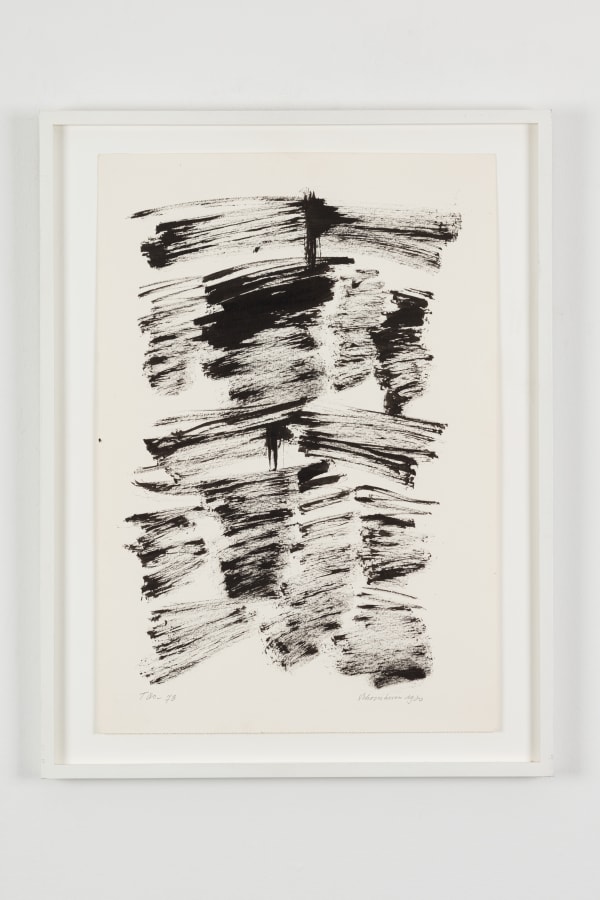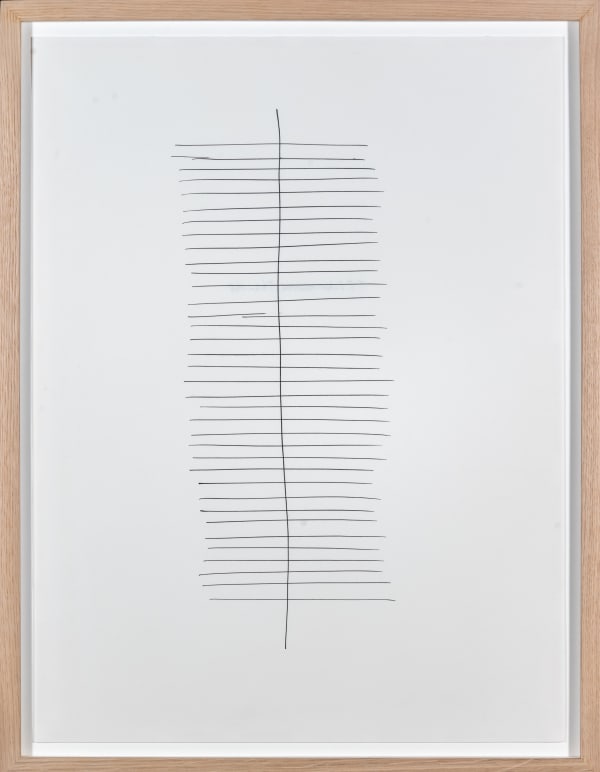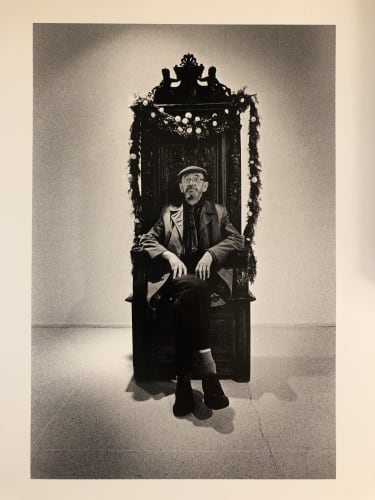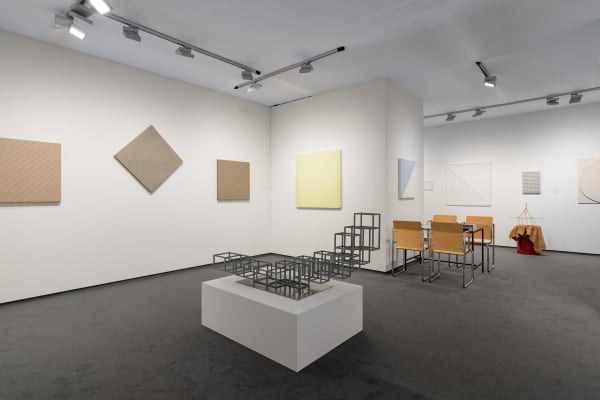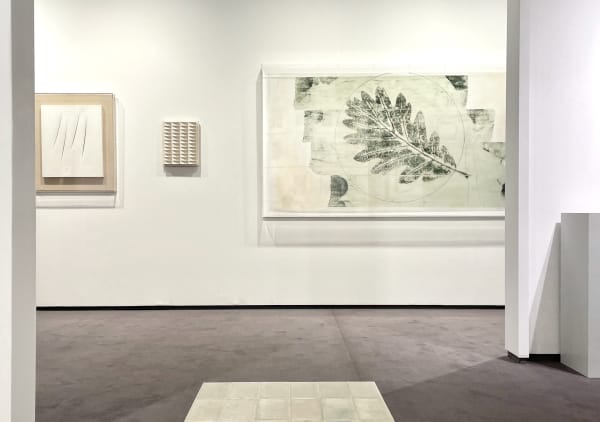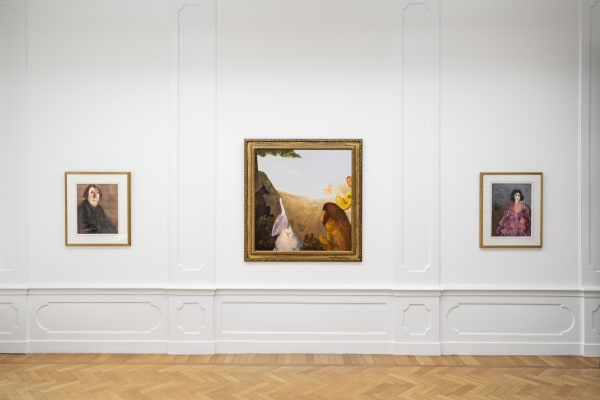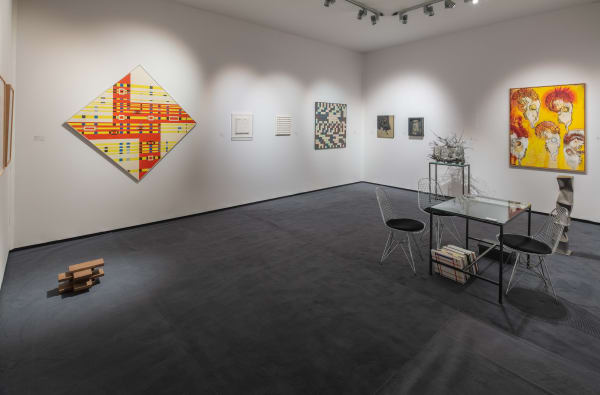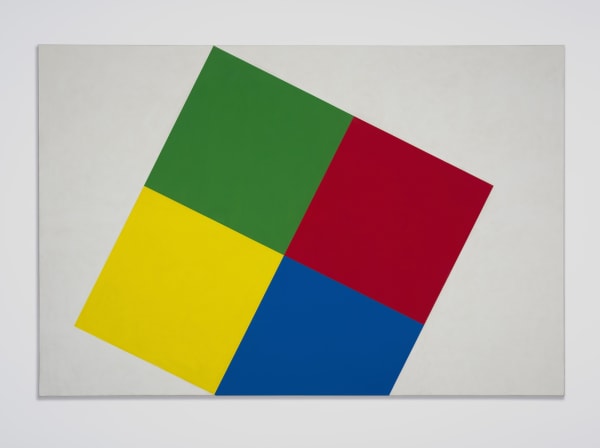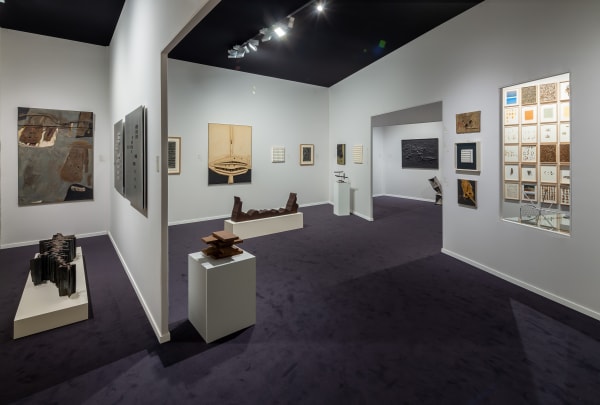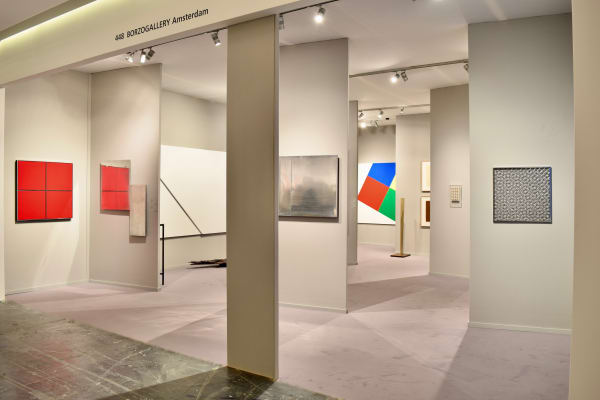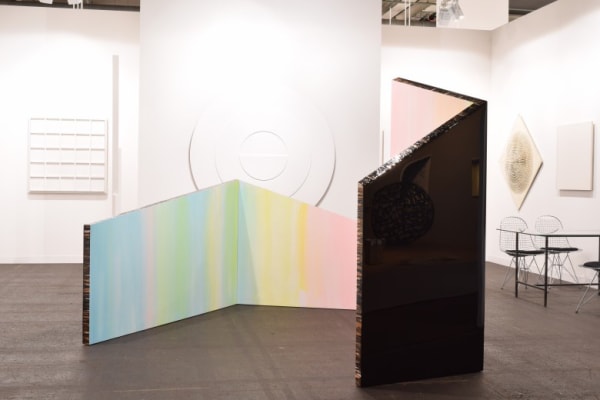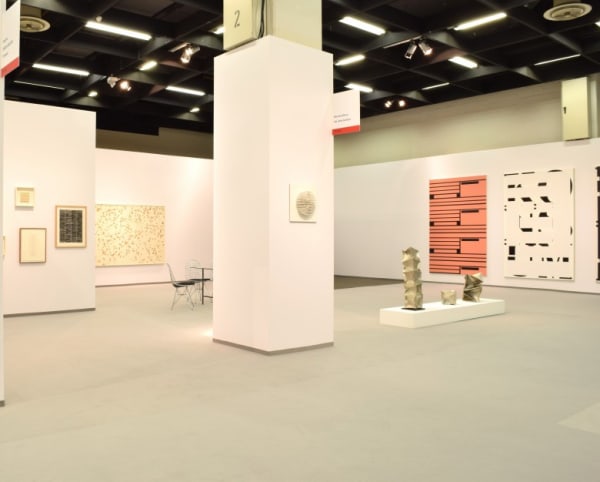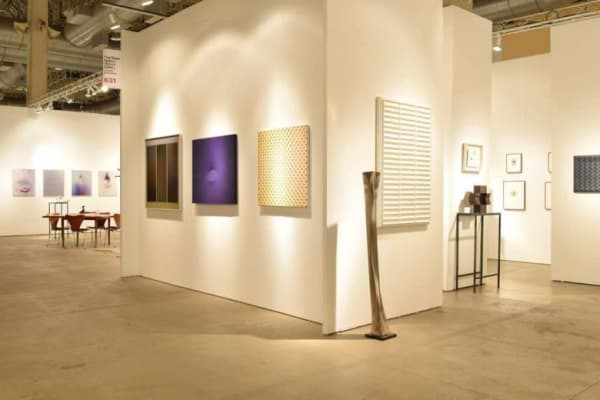Jan Schoonhoven Dutch, 1914-1994
Jan Schoonhoven (1914-1994) is considered to be one of the Netherlands' most important artists of the second half of the twentieth century. He is often called the heir and successor of Mondrian and his Neoplasticism. The white reliefs that have characterized his work since the early nineteen-sixties demonstrate a totally authentic and individual idiom, which has established this artist's international reputation. Initially Jan Schoonhoven's work still revolved around figuration and revealed a particular fondness for Paul Klee.
In Paris a visit to Bram Bogart, who had settled there but was a fellow countryman from Delft, would affect Schoonhoven's later visual language and use of material. In the late nineteen-fifties and together with others such as Armando, Henk Peeters and Jan Henderikse, Schoonhoven founds the Informele Groep that in 1961 is transformed into the NUL group, of which herman de vries is also initially a member. In 1958 Schoonhoven and his friends were already in contact with kindred spirits abroad such as Fontana, Manzoni and Kusama. NUL was the Dutch answer to the German ZERO of Mack, Piene and Uecker, with whom there were also close and friendly links.
Classically trained at the Royal Academy of Arts in The Hague Jan Schoonhoven is predestined to become an art teacher. As for many artists of his generation, career and development are ruptured dramatically by the war years. After the war he provides a fixed income for his young family, not as an art teacher but as a post office official. He would remain in his office job at the head quarters in The Hague until his retirement in 1979. This regularity and organization in his working life as an official were very important to Schoonhoven and their significance to his oeuvre and success as an artist should not be underestimated.
Collectors and museums had already identified his unique talent by the early sixties and various solo and group exhibitions in the major Dutch museums followed, with events progressing just as quickly internationally, especially after his extremely successful participation in the Sao Paulo Biennale in 1967 and Documenta 4 in Kassel in 1968.
Simplicity of form and material and the serial and repetitive pattern in their own abstract visual language are what characterize Schoonhoven's white reliefs. Schoonhoven was also fascinated by the ever-changing effect of light on his reliefs.
Work by Schoonhoven can be found in key museum collections throughout the world such as:
The Museum of Modern Art (MoMA) New York, The Art Institute Chicago, Tate Gallery London, Centre Georges Pompidou Paris, Musee de Grenoble, Neue Nationalgalerie Berlin, Kunsthalle Hamburg, Museum Ludwig Köln, Folkwang Museum Essen, Situation Kunst (für Max Imdahl) Bochum, Kunsthaus Zürich, Louisiana Museum of Modern Art Denmark, Moderna Museet Stockholm, Helsinki Art Museum and in many other museums worldwide.
And throughout the Netherlands, including:
Rijksmuseum Amsterdam, Stedelijk Museum Amsterdam, Gemeentemuseum The Hague, Museum Boymans van Beuningen, Kröller-Müller Museum Otterlo, Van Abbemuseum Eindhoven, Rijksmuseum Twente Enschede, Stedelijk Museum Schiedam. Groninger Museum, Centraal Museum Utrecht, Teylers Museum Haarlem, Coda Museum Apeldoorn.
-

TEFAF Maastricht 2025
Stand 434 13 - 20 Mar 2025Ben Akkerman | Woody van Amen Jan Andriesse | Armando Carel Balth | Charlotte Caspers Ad Dekkers | Ger van Elk Hans van Hoek | Thomas Luther Tomas Rajlich |...Read more -

PAN Amsterdam 2024
Stand 36 23 Nov - 1 Dec 2024Akkerman's oeuvre developed cautiously and resolutely in equal measure. Even in his teens, he drew and painted farms, watermills and landscapes. In the early 1960s, his figuration was characterized by...Read more -

TEFAF Maastricht 2024
Stand 430 9 - 14 Mar 2024Ben Akkerman | Armando Constant | Ad Dekkers Daan van Golden | Jean Gorin Ewerdt Hilgemann | Hans van Hoek Tadaaki Kuwayama | Bart van der Leck Piero Manzoni |...Read more -

TEFAF Maastricht 2023
Stand 430 9 - 19 Mar 2023Carl Andre | Constant Ger van Elk | Lucio Fontana Jacoba van Heemskerck | Hans van Hoek Heringa/Van Kalsbeek Bart van der Leck | Guiseppe Penone Jan Schoonhoven | Carel...Read more -

Opening gallery season 22/23
2 Sep - 8 Oct 2022After the Corona years of cultural poverty, of temporary closures of museums, theaters and galleries, of cancellations and visitor restrictions, of do's and don'ts, it is a beneficial experience to...Read more -

TEFAF Maastricht 2022
Stand 449 25 - 30 Jun 2022After a long break, TEFAF Maastricht - and with it BorzoGallery - can meet the public in person again. We look forward to welcoming you to our stand, where we...Read more -

Art Rotterdam 2021
Stand 74 30 Jun - 4 Jul 2021HERINGA/VAN KALSBEEK | HANS VAN HOEK || JAN HENDERIKSE | HENK PEETERS STAND 74 In 2020, the Kunstmuseum Den Haag bought Hunting Clouds , 2018. This sculpture is now on...Read more -

Art Affair. The Summer edition
Stand 8 17 - 20 Jun 2021TWELVE DUTCH ART DEALERS ENTER INTO AN ART AFFAIR FOR THE SECOND TIME The small-scale art fair Art Affair will take place for the second time in the ballrooms of...Read more -

AFTER NUL - the late works
23 Apr - 22 May 2021Zero in Germany, Azimuth in Italy, Nouveau Réalisme in France, and Nul in the Netherlands are related genres that have had a major influence on the history of art. Held...Read more -

The DAAF 2021
ONLINE ONLY 9 - 11 Apr 2021From 9 to 11 April 2021, members of the Royal VHOK organize the online fair The DAAF | The Dutch Art & Antiques Fair. The first online art fair in...Read more -

The Drawing
1 Feb - 30 Apr 2021More than all other visual art forms, the drawing shows the most direct and most intimate insight into the soul of the artist. Drawing as a direct transfer from the...Read more -

Earth & Light | Jaap Wagemaker & Jan Schoonhoven
3 Sep - 3 Oct 2020In 1959 Hans Sonnenberg organized the ZERO exhibition in the Rotterdamse Kunstkring, with work by Manzoni, Van Bohemen, Tajiri, Wagemaker and Schoonhoven among others. A year before this, Hans Sonnenberg,...Read more -

TEFAF Maastricht 2020
Stand 448 5 - 15 Mar 2020BorzoGallery is pleased to participate in TEFAF Maastricht in 2020. Just as in previous years, a striking stand is designed by the Amsterdam firm HOH Architecten . The larger of...Read more -

Frieze Masters 2019
Stand E12 2 - 6 Oct 2019Jan Schoonhoven (1914-1994) was one of the most modest artists imaginable: he remained a civil servant at the Dutch Post Office right up to his retirement. Alongside his life as...Read more -

Lang niet gezien, nog niet gezien
6 Apr - 1 Jun 2019A group exhibition featuring fifty key artworks from the Borzo collection, spanning approximately the past fifty years ; from Leon Adriaans to Bob Bonies, from Jan Schoonhoven to Rakuko Naito,...Read more -

TEFAF Maastricht 2019
16 - 24 Mar 2019A participant from the very first beginning of TEFAF, BorzoGallery is pleased to announce its presence again in this famous Maastricht art fair. We are proud to present a coherent...Read more -

TEFAF Maastricht 2018
Stand 448 10 - 18 Mar 2018The BorzoGallery stand at TEFAF 2018 was designed by HOH Architecten from Amsterdam. This young architect team has created an exciting design in which the many sculptures that BorzoGallery shows...Read more -

Fall Exhibition
"Just for a few weeks" 21 Oct - 11 Nov 2017With works by: Jan Commandeur, Constant, Ger van Elk, Jan Henderikse, Jeroen Henneman, Carlijn Mens, Vincent Mentzel, Piet Moget, Gordon Newton, Jan Schoonhoven, Peter Struycken, JCJ Vanderheyden, Carel Visser, Koen...Read more -

Art Basel 2017
15 - 18 Jun 2017Monochrome Dutch artists from the sixties and beyond. BorzoGallery is presenting an unique collection of monochrome works from Dutch artists during Art Basel 2017: Armando, Bram Bogart, Ad Dekkers, Ger...Read more -

Art Cologne 2017
Stand A1 26 - 29 Apr 2017During Art Cologne 2017 we will show a number of beautiful reliefs and drawings by Jan Schoonhoven. In addition, we will show a large work by Herman de vries: 'unter...Read more -

EXPO Chicago 2016
21 - 25 Sep 2016BorzoGallery & The Mayor Gallery are pleased to participate in EXPO Chicago 2016 with works by Anne Appleby, Bram Bogart, Ger van Elk, Jan Schoonhoven and herman de vries.Read more -

Art Basel 2013
Stand G6 13 - 16 Jun 2013Borzo gallery is showing at Art Basel 2013 a one-man show by Jan Schoonhoven. 9 reliefs and a number of beautiful drawings, covering his career 1950 - 1990. You can...Read more
-
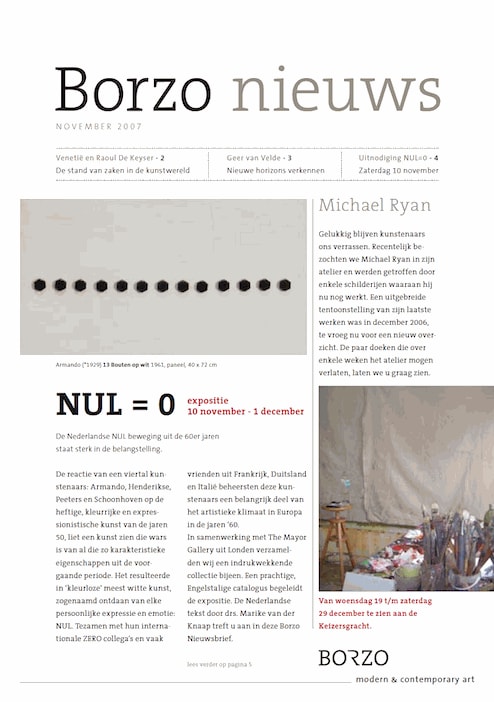
BorzoNews #02
Nul = 0 Paul van Rosmalen Read more -
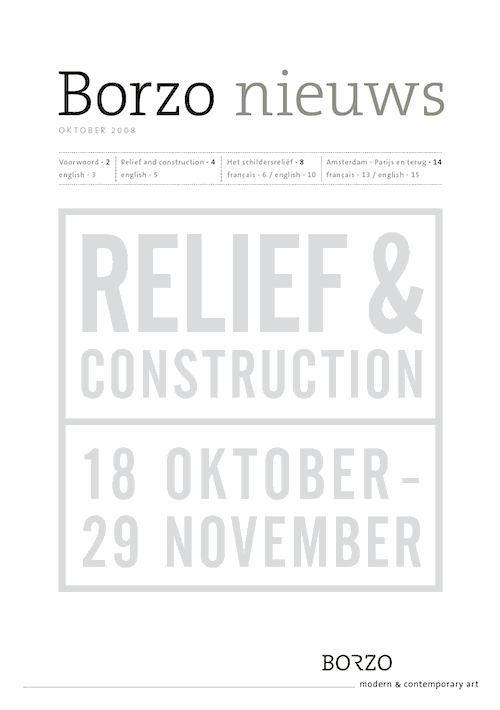
BorzoNews #07
Relief & Construction Paul van Rosmalen Read more -
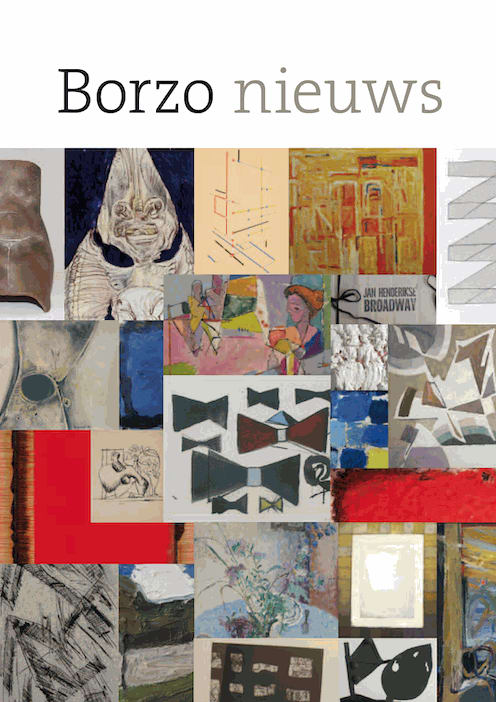
BorzoNews #13
Accrochage l Great Art, Fair Value. Paul van Rosmalen Read more -

BorzoNews #21
Line & Surface Paul van Rosmalen Read more -

BorzoNews #25
After Zero Paul van Rosmalen Read more -
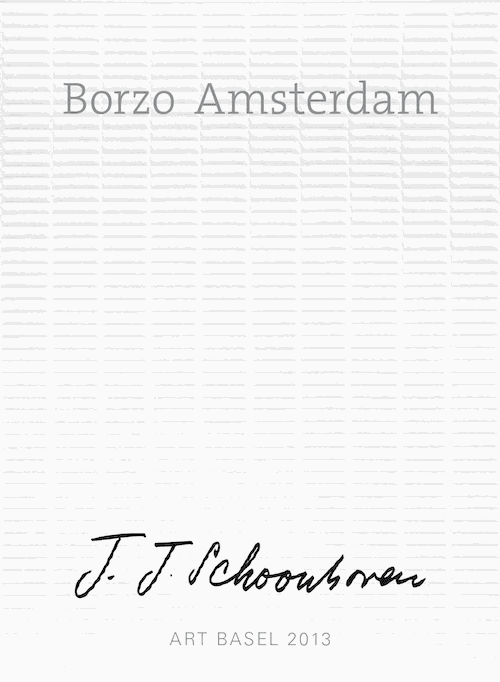
BorzoNews #32
J.J. Schoonhoven at Art Basel Paul van Rosmalen Read more -
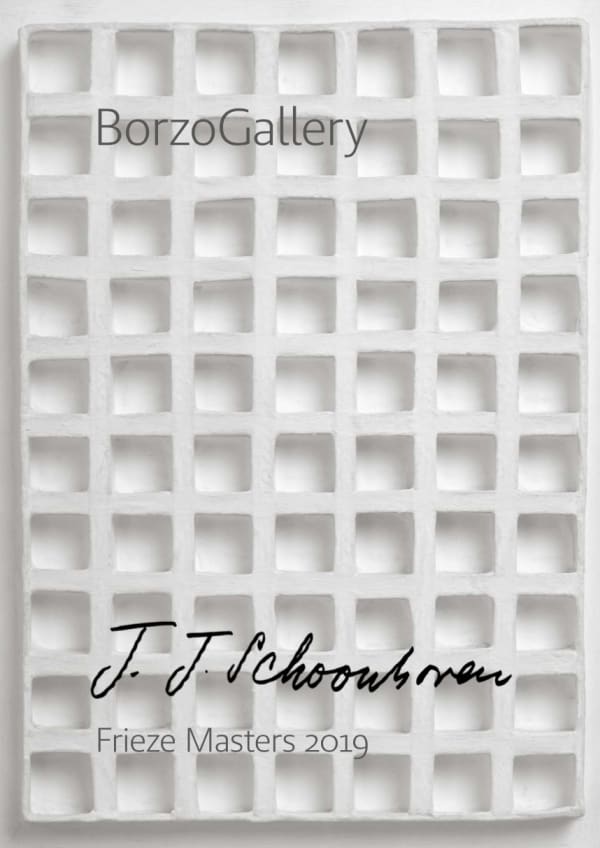
BorzoNews #66
J.J. Schoonhoven l Frieze Masters 2019 Paul van Rosmalen Read more -

BorzoNews #69
Wagemaker & Schoonhoven l Earth & Light Paul van Rosmalen Read more
-

De galerie van... Paul van Rosmalen in conversation with Gallery Viewer (in Dutch)
December 24, 2021In de rubriek 'De galerie van' laat Gallery Viewer een keur aan galeriehouders uit Nederland en België aan het woord: hoe (en wanneer) zijn ze...Read more -

Announcement: Jan Schoonhoven | Catalogue Raisonné
October 1, 2020The Jan Schoonhoven Foundation has recently started the Jan Schoonhoven Research Project to create a catalogue raisonné containing all the reliefs of the artist Jan...Read more -

Amsterdam Art & Antiques Week
September 19, 2020DE HISTORISCHE 'KUNSTBEURS' FROM SLUIJTERS IN A PARKING GARAGE, TO PORSELAIN IN A SOUTERRAIN 19 - 27 SEPTEMBER OPEN DAILY FROM 11 AM TO 6...Read more
SELECTED PUBLIC COLLECTIONS
Art Institute of Chicago
Centraal Museum, Utrecht, the Netherlands
Centre Georges Pompidou, Paris
CODA Museum, Apeldoorn, the Netherlands
Daimler Art Collection, Stuttgart/Berlin
Fonds Régional d'Art Contemporain, Dijon, France
Fries Museum, Leeuwarden, the Netherlands
Gemeentemuseum Den Haag, The Hague, the Netherlands
Groninger Museum, Groningen, the Netherlands
Hamburger Kunsthalle, Germany
Haus Konstruktiv, Stiftung für konstruktive und konkrete und konzeptuelle Kunst, Zurich, Switzerland Josef Albers Museum Quadrat Bottrop, Germany
Kaiser Wilhelm Museum, Krefeld, Germany
Kunsthalle Nürnberg, Nuremberg, Germany
Kunsthalle Tübingen, Germany
Kunsthalle zu Kiel, Germany
Kunstmuseum Bochum, Germany
Kunstmuseum Bern, Switzerland
Kunsthaus Zürich, Zurich, Switzerland
Kunstsammlungen der Ruhr-Universität, Bochum, Germany
Louisiana Museum Humlebaek, Denmark
Malmö Konsthall, Sweden
Moderna Museet, Stockholm
Musée d'Art et Histoire, Grenoble, France
Musée des Beaux Arts, Beaune, France
Museum Abteiberg, Mönchengladbach, Germany
Museum Boijmans van Beuningen, Rotterdam, the Netherlands
Museum Folkwang, Essen, Germany
Museum Het Valkhof, Nijmegen, the Netherlands
Museum Kunstpalast, Düsseldorf
Museum Ludwig, Cologne
Museum Morsbroich, Leverkusen, Germany
The Museum of Modern Art, New York
Museum van Bommel van Dam, Venlo, the Netherlands
Muzeum Sztuki, Lodz, Poland
Neue Nationalgalerie, Berlin
Rijksdienst voor het Cultureel Erfgoed, Rijswijk, the Netherlands
Rijksmuseum, Amsterdam
Rijksmuseum Kröller-Müller, Otterlo, the Netherlands
Rijksmuseum Twenthe, Enschede, the Netherlands
Ritter Art Gallery, Boca Raton, Florida
Saarland Museum, Saarbrücken, Germany
Situation Kunst (für Max Imdahl), Bochum, Germany
Staatsgalerie Stuttgart, Germany
Städtische Galerie Nordhorn, Germany
Stedelijk Museum, Amsterdam
Stedelijk Museum Schiedam, Schiedam, the Netherlands
Taidemuseo, Helsinki, Finland
Tate Gallery, London
Teylers Museum, Haarlem, the Netherlands
Ulmer Museum, Ulm, Germany
Van Abbemuseum, Eindhoven, the Netherlands
Von der Heydt-Museum, Wuppertal, Germany
Westfälisches Landesmuseum, Münster Germany
Wilhelm-Hack-Museum, Ludwigshafen am Rhein, Germany
Wilhelm Lehmbruck Museum, Duisburg, Germany



